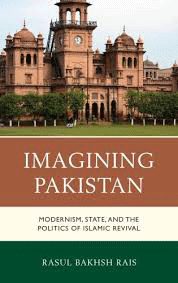Book Review: Imagining Pakistan
By K. K. Shahid | Bookmark | Published 7 years ago

At a time when a new government has been tasked with addressing a myriad old problems facing the country, Imagining Pakistan: Modernism, State, and the Politics of Islamic Revival underlines the core issues that the nation expects to be resolved.
Rasul Bakhsh Rais’ Imagining Pakistan, which appeared last year, was almost immediately followed up by the release of Islam, Ethnicity and Power Politics this year, which addresses the question of formulating a national identity. But it is in Imagining Pakistan, that the author focuses on the past and the present to dissect where the state has erred, before proceeding to the many solutions in the book that followed.
From the onset, the book attempted to outline what exactly has gone wrong with the country over the past seven decades. First, there is the military’s usurpation of the civilian domain with four coups, along with abrogated – and tampered – constitutions. Second, the political leadership has been dishonest and inefficient, lacking a vision to address the gamut of problems that they and the military leaders have collectively amassed. Third, the state’s volatility, owing in large part to the violence that has religious, political and ethnic roots, and has dented the societal roots.
At the heart of the book is a quest to trace the role of Islam in Pakistan, which the author argues was created owing to Muslim modernism, nationalism and struggle for empowerment, and was never intended to be an orthodox Islamic state. The author maintains that the rise of radical Islam and the ensuing terrorism is owing to the abandonment of the liberal ideas of the country’s founders.
Imagining Pakistan argues that there has been a three-pronged slugfest between democracy, military rule and Islam to shape up the Pakistani state and nation, with these three forces ‘fundamentally in conflict.’ Hence, the biggest challenge in nation-building has been finding a compromise between these conflicting forces and how they envision the ideological and institutional structure of the country.
The book maintains that the contrasting role of Islam in the Pakistani state is owing to the divergent meaning extracted from the meaning of Pakistan and its creation. Rais maintains that those wanting to carve out an Islamic state within Pakistan share a common goal with Islamist terrorists.
“There are a number of religious political parties and Islamic groups in Pakistan that share the ideal of an Islamic state with the Taliban and other radical groups. The difference between the radicals and the mainstream religious parties is mainly regarding the means for achieving this ideal.”
The author’s argument for the creation of a modern Muslim state is founded upon his thesis that the idea of Pakistan itself was the culmination of Muslim reformism in the Indian subcontinent, which developed in various phases. Over the decades, ethos and visions clashed and, in turn, empowered Muslims to a point where they challenged the idea of British rule, or a self-asserting Hindu majority.
“The Muslim reformers, beginning with literature, science, and religious thought, shaped several identical cultural movements with a similar objective; that is, the revival of the power and influence of the Muslim community and how best to strive for achieving rights and the rightful place for Muslims in the politically evolved British Indian Empire.”
So how did that modernism erode? Was it owing to the British colonialist power? The book argues that the imperialistic forces hindered the organic development of cultures, social values and political institutions, not to mention the taking over of the local population’s sovereignty. It says that the colonialist imprints on British India were inherited by Pakistan as well, in the shape of weakened institutions and the system of governance.
Even so, Imagining Pakistan reiterates that Pakistan today is significantly weaker than it was a few decades ago. And most of the rot is self-inflicted, especially in recent times. Among the many factors that are responsible for the state’s decline is the rise of radical Islam, which no one has taken ownership of.
“The ruling classes of Pakistan have been able to weave a clever narrative that shifts the causes of radical Islam away from their own serious political failings to internal characteristics of the Islamist militant groups, such as the role of Islamic educational institutions, intolerant religious culture, and a sectarian mindset manipulated by external forces. While these characteristics of radical Islam are not off the mark, and its steady rise and violent expression has been aided by multiple national, regional, and international factors, major failings of the Pakistani state have been the major reason for the rise of radical Islam.”
But what exactly is the nature of the Islamist threat? Also does political Islamism really challenge the liberal concept of the Pakistani state? How much of it has to do with the Zia-ul-Haq regime providing space to Islamist groups in the 1980s? These are a few questions that the book goes on to address, while arguing that the state has regularly erred in dealing with the mullahs.
“The appropriation of the Islamic pulpit by political elites, or playing on the Islamic wicket to use cricket terminology, has forced them to play a defensive game against the mullahs who know the bounce and pace of the wicket far better than them.”
In conclusion, the author urges the state to confront violent groups, rethink geopolitical realism, embrace pluralism, and retrace its modernistic roots in order to provide a liberal framework and generate hope for nation-building in Pakistan.


